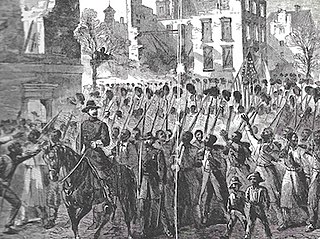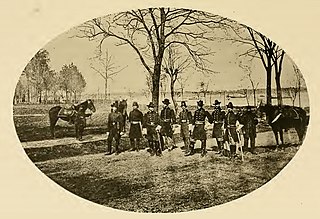The 60th Regiment Massachusetts Volunteer Infantry was an infantry regiment that served in the Union Army during the American Civil War from 1864 to 1865.
The 62nd Massachusetts Volunteer Infantry Regiment was an infantry regiment being raised to serve in the Union Army during the American Civil War. The war ended before the unit was complete.

The 4th Massachusetts Volunteer Heavy Artillery Regiment was a unit that served in the Union Army during the latter part of the American Civil War. It was formed from former Unattached Companies of Heavy Artillery raised by Massachusetts to serve the state and for the defenses of Washington, D.C.

The 1st Massachusetts Volunteer Heavy Artillery Regiment was a unit that served in the Union Army during the American Civil War. It was originally raised as the 14th Massachusetts Volunteer Infantry Regiment.
The 3rd Massachusetts Volunteer Heavy Artillery Regiment was a unit that served in the Union Army during the American Civil War. It was organized from already mustered unattached companies of heavy artillery raised for the defenses of the Massachusetts coast.
The 1st Battalion of Massachusetts Volunteer Heavy Artillery was a unit that served in the Union Army during the American Civil War. It was organized from several unattached companies of heavy artillery already raised and mustered into a three-year service for the defenses of the Massachusetts coast.
The 61st Regiment Massachusetts Volunteer Infantry was an infantry regiment raised for one year's service in the Union Army during the American Civil War from 1864 to 1865.

The 7th Regiment Massachusetts Volunteer Infantry was an infantry regiment in the Union army during the American Civil War. It was formed on June 15, 1861, in Taunton. Its original commander was Colonel Darius N. Couch who would eventually be promoted to command the II Corps of the Army of the Potomac and, after that, the Department of the Susquehanna.

The 17th Massachusetts was an infantry regiment that served in the Union Army during the American Civil War.

The 55th Massachusetts Infantry Regiment was the sister regiment of the renowned Massachusetts 54th Volunteers during the latter half of the American Civil War. The enactment of the Emancipation Proclamation by United States President Abraham Lincoln on January 1, 1863 opened the way for the enlistment of free men of color and newly liberated slaves to fight for their freedom within the Union Army. As the ranks of the 54th Massachusetts quickly reached its full complement of recruits, an overflow of colored volunteers continued to pour in from several other states outside Massachusetts — many of whom simply had not arrived in time — prompting Governor John Albion Andrew to authorize yet another regiment of colored soldiers sponsored by the Commonwealth. Lieutenant Colonel Norwood P. Hallowell of the 54th Massachusetts was promoted to colonel and appointed commander of the 55th Massachusetts on May 30, 1863. Five companies of the 55th Massachusetts were mustered into service on May 31; two more companies were mustered in on June 15; and the last three on June 22.

45th Regiment Massachusetts Volunteer Infantry was an infantry regiment in the Union army during the American Civil War. The regiment trained at Camp Meigs in Readville, Massachusetts before traveling to North Carolina, where they fought in the Battle of Kinston in December 1862, and in skirmishes in and around New Bern, North Carolina in the spring of 1863. They suffered heavy casualties in battle and due to fever. In June they returned to Boston, where they patrolled the streets to quell any draft riots, and were discharged on July 21. They were commanded by Colonel Charles R. Codman (1829-1918).
The 3rd Massachusetts Volunteer Cavalry Regiment was a cavalry regiment that served in the Union Army during the American Civil War. It was organized by consolidating the 41st Massachusetts Mounted Infantry and the 2nd Battalion Massachusetts Cavalry on June 17, 1863. The regiment served with the XIX Corps, Army of the Gulf during the Red River Campaign in 1864. Its heaviest combat during this campaign took place during the Battle of Sabine Crossroads.

The 42nd Regiment Massachusetts Volunteer Infantry was a regiment of infantry that served two tours in the Union Army during the American Civil War. The unit was first formed in September 1862 in response to President Abraham Lincoln's call for 300,000 men to serve for nine months.

The 43rd Regiment Massachusetts Volunteer Infantry was a regiment of infantry that served in the Union Army during the American Civil War. The unit was first formed in September 1862 in response to President Abraham Lincoln's call for 300,000 men to serve for nine months. The nucleus of the regiment was the Second Battalion Massachusetts Volunteer Militia, a unit dating to 1798 known as the Boston Light Infantry and nicknamed the "Tigers." The 43rd Massachusetts therefore became known as the "Tiger Regiment."

The 59th Massachusetts Volunteer Infantry Regiment was a unit of the Union Army during the American Civil War. It was one of the four Massachusetts "Veteran Regiments" raised in the winter of 1863–64. Recruits joining these regiments were required to have served at least nine months in a prior unit. The regiment was attached to the IX Corps of the Army of the Potomac and took part in Lieutenant General Ulysses S. Grant's Overland Campaign in the spring of 1864. They participated in heavy combat during several battles including the Battles of the Wilderness, Spotsylvania Courthouse, and the Crater.

The 2nd Massachusetts Battery was an artillery battery that served in the Union army during the American Civil War. The unit was initially known as "Cobb's Light Artillery" for its first commander, Major Moses Cobb. An experienced officer of the Massachusetts militia, Cobb was selected to organize and command the battery on April 20, 1861, however he did not go with the unit when it departed for the field. The unit was later known as "Nim's Battery" after its subsequent commanding officer, Capt. Ormand F. Nims. It was one of the Massachusetts regiments organized in response to President Abraham Lincoln's call on May 2, 1861, for volunteer troops to serve a term of three-years. The 2nd Massachusetts Battery was the first unit of artillery to be recruited in Massachusetts for three-years service. The battery trained at Camp Adams in Quincy, Massachusetts, and was mustered into federal service on July 31, 1861.

The 4th Massachusetts Battery was an artillery battery that served in the Union Army during the American Civil War. The unit was sometimes known as "Manning's Battery" after its commanding officer, Capt. Charles H. Manning. It was one of the Massachusetts regiments organized in response to President Abraham Lincoln's call on May 2, 1861 for volunteer troops to serve a term of three-years. The core of the unit was a peace-time militia company known as the Salem Light Artillery. The battery trained at Camp Chase in Lowell, Massachusetts. It was assigned to the Department of the Gulf under Major General Benjamin F. Butler and departed Boston by steamship on November 20.

The 5th Massachusetts Battery was an artillery battery that served in the Union army during the American Civil War. It was one of the Massachusetts regiments organized in response to President Abraham Lincoln's call on May 2, 1861 for volunteer troops to serve a term of three-years. The battery trained at Camp Shouler in Lynnfield, Massachusetts and Camp Massasoit in Readville, Massachusetts. It departed Boston by steamship on December 25, 1861.

The 7th Massachusetts Battery was an artillery battery that served in the Union Army during the American Civil War. The original core of the unit was a company of infantry known as the Richardson Light Guard. The company initially served provost duty at Fortress Monroe, was eventually trained in light artillery drill, and reorganized on March 17, 1862 as the 7th Massachusetts Battery.

The 11th Massachusetts Battery was an artillery battery that served in the Union Army during the American Civil War. It was formed in response to President Abraham Lincoln's August 1862 call for 300,000 men to serve for nine months. Several months after completing their first term of service, the battery was reorganized for a second term of three years. It was recruited by Captain Edward J. Jones of Boston and consisted almost entirely of men from that city. The battery served a largely uneventful first term as garrison troops mostly in Centreville, Virginia. During their second term they were involved in heavy combat being part of the Army of the Potomac during Lieutenant General Ulysses S. Grant's Overland Campaign.











